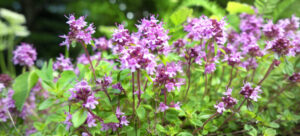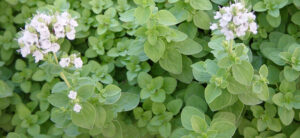
If you're pondering which new herb to add to your garden, consider learning how to grow marjoram from seed to harvest.
Most beginners start out with easy-to-grow herbs, like basil and oregano - but very few consider growing marjoram.
However, this herb is shockingly easy to grow and should be a staple in any garden. It makes a great companion plant, and adds some serious flavor to a variety of dishes.
It can be sown from seed indoors and transplanted outside, planted directly in the garden, or grown as a potted plant. It can even be grown hydroponically!
No matter how you choose to grow it, these tips will get you started off on the right foot when you are learning how to grow marjoram.
What Is Marjoram?
Marjoram is a perennial herb that has a profound piney, citrusy flavor. Native to the Mediterranean region, this herb was not introduced to the United States until after World War II.

It is hardy in zones 5-9 in most cases but can be grown as an annual or an indoor plant just about anywhere else.
Part of the mint family, it’s closely related to oregano. It has a sweet, spicy, and somewhat floral fragrance and can be used both fresh and dried.
What Are The Benefits Of Growing Marjoram?
growing marjoram is typically done for its aromatic leaves, which can be consumed either fresh or dried. It is often used to add zest to meat dishes, salad dressings, and preserved meats (like sausages).
It’s frequently used for vegetables and tomato-based dishes, too.This herb has a ton of medicinal benefits as well.
It has been used as a tonic to treat nervous and cardiovascular problems along with coughs, migraines, dizziness, digestive issues, and even sinus problems.
Is There A Difference Between Marjoram & Sweet Marjoram?
There are technically two species of marjoram for you to know about - Spanish marjoram, or oregano, and sweet marjoram, the well-known culinary herb that this article will center around. Sweet marjoram, or Origanum majorana, is cultivated in gardens all over the world.
In some places, particularly in the Middle East, marjoram is a word that is used synonymously with oregano.
Therefore, the terms “sweet marjoram” and even “knotted marjoram” are used to differentiate between the two.
What Do You Need To Start Growing Marjoram?

When growing marjoram, you will need to have good potting soil with excellent drainage. This is one plant that does not like to keep its feet wet!
If you plan on growing marjoram indoors or in containers, you’ll also need some good garden pots.
Fabric garden pots are a great choice since they’ll provide the oxygenation of the root zone and drainage your plants need to stay healthy.
You may want to pick up a fertilizer to have on hand, too. Since marjoram is grown for its leaves, encouraging foliage growth with the right nutrients is essential. A well-balanced 10-10-10 fertilizer or even some compost tea should do the trick.
If you plan on starting your seeds indoors, you'll need a seed starting kit. These are great, because they allow you to quickly and efficiently germinate seeds in bulk.
Does Marjoram Need Full Sun?
Marjoram grows best in full sun. It can tolerate small amounts of shade, but may grow in a less bushy fashion.
If you have an indoor garden or even a greenhouse, you will likely need some grow lighting. Just fluorescent T5 grow lights or low intensity LED grow lights will work fine for this type of plant.
If you're just starting your indoor garden, consider our complete grow tent kits. These are a great way to start growing indoors, as they contain everything you need.
The grow tent contains the mess of the garden so you can set this up anywhere indoors without worry of dirt, plant matter, bugs, or water spills.
You can choose the lighting technology you want, a grow method (hydroponics or soil) and you also get a ventilation system.
Now, you came here to learn how to grow marjoram from seed to harvest. Let's get right into it.
How To Grow Marjoram In Your Backyard

You came here to learn how to grow marjoram in your backyard garden, so let's get into it.
We've explained what you need to get this new plant added to the garden. So unless you already have these garden supplies on hand, it's time to do some shopping!
In the meantime, you can read on below to learn everything else you need to know about growing marjoram. It's pretty simple, as are most herbs, but there are just a few key things you need to remember.
How Long Does It Take To Grow Marjoram?
Marjoram seeds take a long time to germinate - usually anywhere between two and three weeks.
However, you’ll be able to harvest your leaves about 60 days after sowing. Other things may delay this, including weather & light exposure, soil fertility, etc.
Starting Marjoram Seeds Indoors Before Moving Outdoors
One of the easiest ways to grow marjoram is to start seeds indoors before transplanting larger seedlings outdoors.

To do this, you’ll need to plan ahead to start your seeds about eight to ten weeks before the last expected frost date in the spring.
Sow your seeds about a quarter of an inch deep in seed-starting formula and keep the soil moist, around 70 degrees, until the seedlings emerge.
Like most herbs, it can take some time for seedlings to appear - up to three weeks, in many cases. Once they do, provide lots of light, keeping them about four inches beneath grow lights that are turned on for 16 hours per day.
Raise the seedling lights as your plants grow taller. You don’t need to fertilize the seedlings, but you can if you’d like to encourage leaf growth.
Do this when the plants are around four weeks old. Depending on the size of your seed starting cells, you might need to transplant your seedlings when they have three pairs of leaves, too, putting them in larger containers until you’re ready to transplant them into the garden.
Planting Marjoram Seedlings In The Garden
Before you plant your marjoram seedling in the garden, you need to take some time to harden them off. This will allow them to build the defenses necessary to handle the harsh wind, sun, and temperature conditions outdoors.
To harden off your seedlings, start by putting them outside for just an hour or two each day. Every day, add a few more hours until the seedlings are able to spend all day outdoors.

This will toughen their cell structure and reduce the risk of transplant shock. Plant your seedlings in average soil, selecting a location that receives full sun. wait until the danger of frost has passed. Work a bit of compost into the soil, digging in about seven inches.
Transplant when your seedlings have two pairs of leaves and dig a hole that is large enough to generously accommodate the entire root ball of the plant.
Remove the plant from the pot with care, loosening the roots as you do so. Arrange the root ball so it is even with the level of the surrounding soil, then fill with soil to the top.
Press down firmly with your hand and water thoroughly. Apply a bit of mulch around the transplant to reduce weeds and conserve water.
What Conditions Does Marjoram Like?
Marjoram plants should be grown about 12 inches apart in full sun. It prefers rich, well-draining soil with a pH between 6.7 and 7.0. It should remain well-watered but not too wet.
Monitoring Marjoram Diseases & Problems

Marjoram is a relatively hardy plant with few pest and disease problems to worry about. However, there are a couple to keep an eye out for.
Botrytis Blight
One is botrytis blight. Also referred to as gray mold, botrytis blight causes a fungus to appear on plant stems and leaves.
The diseased leaves will fall off and die. If the infection is severe, the entire plant might die. It flourishes in high humidity and cool temperatures.
The best way to prevent botrytis blight is to make sure your plants have proper air circulation by spacing and pruning them appropriately. If you're growing indoors, this requires some circulation fans.
Damping Off
Another issue you might encounter is damping off. This disease often happens when you are starting plants from seed.
It’s hard to detect, too, as the seedling will emerge and appear to be healthy - then, it will start to wilt and die for no apparent reason.
It is also caused by a fungus that thrives in high humidity. If your soil is too wet or contains too much nitrogen, your plants are at an increased risk. Avoid overwatering and again, provide proper air circulation.
Aphids
The primary pest of marjoram is the aphid. These sucking insects spread disease as they feed on the undersides of marjoram leaves. They also leave behind a sticky substance, honeydew, that attracts ants.
Encourage natural predators, like lady beetles, in your garden. You can also use insecticidal soap or an insecticide to get rid of aphids.
Does Marjoram Grow Back Every Year?
Depending on where you live, you might be able to keep your marjoram going strong for many years.
In zones 9 and warmer, marjoram is a perennial and can be left in the ground between seasons. In northern climates, it’s only an annual, so you may be better off putting it in a container and bringing it indoors for the winter.
How To Harvest & Store Marjoram

You can begin to harvest your plants when tips appear at the ends of the stems. These should look like tiny little balls.
Cut the plants back close to the ground at this time, which will encourage a new flush of growth. This second growth is often more desirable than a first cutting, possessing far more flavor.
You can air-dry the cut stems and store them in sealed containers. Alternatively, you can dry the leaves in a dehydrator. Discard the stems and keep only the leaves. They’ll last for several months when dried this way.
Final Thoughts On How To Grow Marjoram
Now you know how to grow marjoram. Ready to get started? Whether you’re growing marjoram indoors, outdoors, or in a hydroponic setup, Hydrobuilder has everything you need to get started growing marjoram.
This herb should be a staple in any garden - as well as in any kitchen. And we have the products you need to get it done right!






































